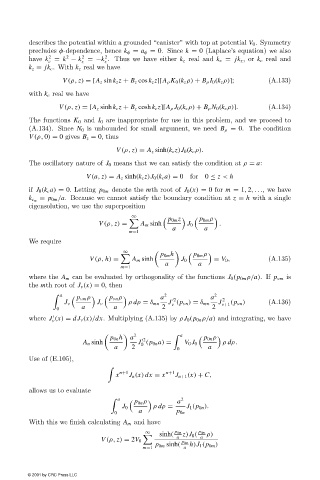Page 507 - Electromagnetics
P. 507
describes the potential within a grounded “canister” with top at potential V 0 . Symmetry
precludes φ-dependence, hence k φ = a φ = 0. Since k = 0 (Laplace’s equation) we also
2
2
2
2
have k = k − k =−k . Thus we have either k z real and k c = jk z ,or k c real and
c z z
k z = jk c . With k z real we have
V (ρ, z) = [A z sin k z z + B z cos k z z][A ρ K 0 (k z ρ) + B ρ I 0 (k z ρ)]; (A.133)
with k c real we have
V (ρ, z) = [A z sinh k c z + B z cosh k c z][A ρ J 0 (k c ρ) + B ρ N 0 (k c ρ)]. (A.134)
The functions K 0 and I 0 are inappropriate for use in this problem, and we proceed to
(A.134). Since N 0 is unbounded for small argument, we need B ρ = 0. The condition
V (ρ, 0) = 0 gives B z = 0,thus
V (ρ, z) = A z sinh(k c z)J 0 (k c ρ).
The oscillatory nature of J 0 means that we can satisfy the condition at ρ = a:
V (a, z) = A z sinh(k c z)J 0 (k c a) = 0 for 0 ≤ z < h
if J 0 (k c a) = 0. Letting p 0m denote the mth root of J 0 (x) = 0 for m = 1, 2,..., we have
= p 0m /a. Because we cannot satisfy the boundary condition at z = h with a single
k c m
eigensolution, we use the superposition
∞
p 0m z p 0m ρ
V (ρ, z) = A m sinh J 0 .
a a
m=1
We require
∞
p 0m h p 0m ρ
V (ρ, h) = A m sinh J 0 = V 0 , (A.135)
a a
m=1
where the A m can be evaluated by orthogonality of the functions J 0 (p 0m ρ/a).If p νm is
the mth root of J ν (x) = 0, then
a 2 2
p νm ρ p νn ρ a 2 a 2
J ν J ν ρ dρ = δ mn J (p νn ) = δ mn J ν+1 (p νn ) (A.136)
ν
0 a a 2 2
where J (x) = dJ ν (x)/dx. Multiplying (A.135) by ρ J 0 (p 0n ρ/a) and integrating, we have
ν
2 a
p 0n h a 2 p 0n ρ
A n sinh J (p 0n a) = V 0 J 0 ρ dρ.
0
a 2 0 a
Use of (E.105),
x n+1 J n (x) dx = x n+1 J n+1 (x) + C,
allows us to evaluate
a
p 0n ρ a
2
J 0 ρ dρ = J 1 (p 0n ).
0 a p 0n
With this we finish calculating A m and have
∞ p 0m p 0m
sinh( z)J 0 ( ρ)
a a
V (ρ, z) = 2V 0 p 0m
p 0m sinh( h)J 1 (p 0m )
m=1 a
© 2001 by CRC Press LLC

